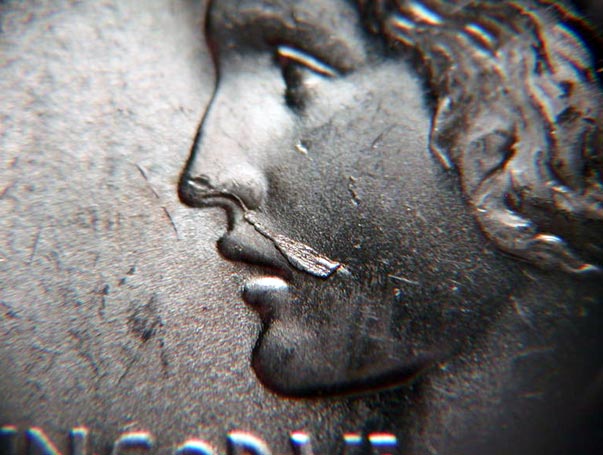-
- Coming Soon!
-
- Coming Soon!
-
- Coming Soon!
VAMLINK Articles
The 1922-P "Moustache" Variety
There are few, if any, U.S. Peace dollar varieties that are as well known or as popular as the 1922-P "Moustache" variety. Indeed, if you ask non-variety coin collectors to name just one Peace dollar variety, it’s more than likely the "Moustache" variety will be the first, and maybe the only one, they mention. Why? The VAM 12A has a dramatic, easily seen "naked-eye" feature that literally demands a double-take. It’s spectacular! Yes, there are other die varieties in the Peace dollar series that are much rarer, but the amazing die break emanating from Liberty’s nose has what we call "wow" power.

Image of the 1922-P VAM 12A "Moustache" variety from the Lloyd Gabbert collection, which at the time was the PCGS #1 Registry Set.
If true, what does this mean for Peace dollar collecting? A specimen of both the VAM 12 and VAM 12A will be sent to Van Allen, and he will make the final determination as to the respective VAM numbers. But a simple solution would be to change the VAM 12 description to match the VAM 12A reverse. The original VAM 12 would then be changed to another number. This makes sense, since many, if not most, of the VAM 12 coins already attributed may be something else, anyway.
In the accompanying chart, we’ve laid out the die progression of the "Moustache" die break, based on the large numbers of coins we’ve examined. Fortunately, we have located a VAM 12 specimen that seems to match the current VAM 12A designation, and we refer to it as the "Pre-Stage," since at this point in the life of the obverse die there are no indications of a future die break. Stage 1 reflects the fact that a die crack is likely to have formed prior to the ensuing die break. However, we have never encountered such a specimen, and the question is: Does anyone have such a coin? Then, in Stage 2 an actual die break is visible as a line of raised metal drooping down from Liberty’s nose. Stage 3 is a greatly expanded version of this die break, and Stage 4 is the Late Die State, which most would agree represents one of the most incredible die break features found on any U.S. silver dollar.
Sorting out the reverse die will do little to detract from the star power of this variety. After all, the iconic Peace dollar "Moustache" variety has captured the imagination of collectors since the earliest days of VAM collecting, and surely will continue to do so. The good news is that Mint State examples are still available, and when I was recently asked about picking up a nice Mint State specimen, I replied as I always do that there’s no better time than now!
| VAM 12 PRE-STAGE | VAM 12 STAGE 1 | |
| 1922-P VAM 12A "Moustache" Variety Obverse: Generic II-1 Reverse: B2-h | The original die state of this obverse and reverse combination is listed by Van Allen/Mallis as the VAM 12 die pair, which is attributable by its doubled die reverse. However, it now seems that the original VAM 12 and today’s VAM 12A reverse, while similar, are not identical. | No Specimen Available For Research Purposes Although we have not been able to locate one, we believe that a stage prior to the initial obverse die break would likely exist. |
| VAM 12A STAGE 2 | VAM 12A STAGE 3 | VAM 12A STAGE 4 |
| Obverse: There’s a thin line of raised metal running down from Liberty’s nostril to a point directly behind her mouth. Notably, there’s a relatively even distribution of metal along the break, like a strand of rope. Reverse: The key feature of this doubled die is the doubling of the leaf edges on the lower reverse. |
Obverse: The width of the feature’s entire length has now dramatically expanded, to the extent that the bottom half of the break has fanned out to become three to four times its former width. Reverse: There are no additional features worth noting on the Stage 3 reverse. |
Obverse: The bottom of the Die Break continues to expand slightly, and is now at least four times that of Stage 3. Unique die fatigue can be seen at the top of the Die Break. Reverse: Even the late die state does not show significant change from S |
No part of this writing or presentation may be reproduced by any means without the written consent of the author.

 The 1921-D VAM 1X Early Die State
The 1921-D VAM 1X Early Die State What's it Worth?
What's it Worth? A Tribute to 8TF Morgans
A Tribute to 8TF Morgans The 1922-P "Moustache" Variety
The 1922-P "Moustache" Variety The Amazing 1886-O VAM 5
The Amazing 1886-O VAM 5